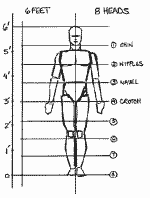
Cylinder Body
8 Head High Model
Click pic to open a large version in a separate window!
| Standard Body Model
This model represents a body that is 8 heads high. These elongated proportions work well for comic art. However, you should know that there are many different Standard Body Models out there (ranging from about 6 head heights to about 9 head heights!).
This model is only a guide! You must realize that God made each of us different, and people (normal and superhero) can vary significantly from this standard. Just as Danny DeVito is different from Arnold Schwarzenegger, so too is Robin different from Superman! You simply cannot apply one rigid model to obtain these diverse characters!
However, it is very useful to learn these proportions. They will help you create, and keep consistent, customized bodies with their own unique, relative proportions.
| |
|
|
Exercise:
- Get your magazines out, and find a picture to study.
- Sketch out a quick cylinder body for the picture. Don't force the sketch to match the proportions of the Standard Model -- the person in the picture may not have those body proportions!
- If you are having trouble, simply use your tracing paper directly over the photo to construct the cylinder body.
- Take your time! There's no rush!
|
|
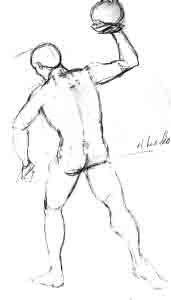
|
Here's a simple cylinder body of a man holding a ball. Note there is virtually no surface detail! All we are concerned with is the structure of the figure.
Notice that this guy is definitely NOT an 8-head high guy! He has his own body type, and I tried to capture that!
|
|
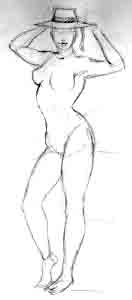
|
This is a figure of a woman trying on a hat. We're not making finished masterpieces here -- we are simply trying to find the structure of the figure in a given pose.
|
|
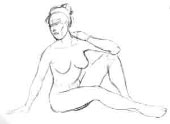
|
This is a figure of a woman resting. Notice the curve of the torso, and the foreshortening (the perspective) of her right thigh. These are the structural details of importance!
|
|
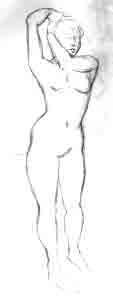
|
This is a figure of a woman fixing her hair. Even if you are capable or rendering the greatest surface detail we have ever seen, if the structure of the object under that surface is incorrect, the drawing will look wrong!
|
|
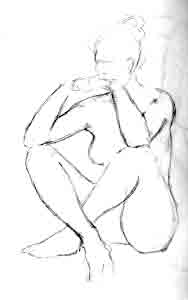
|
This is a figure of a woman sitting contemplatively. It's just like building a skyscraper: you can't install the windows (the final, surface details) until the structural steel (the cylinder body) is in place!
|
|
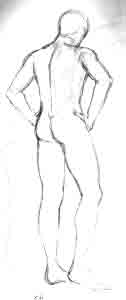
|
This is a figure of a man resting while standing. During this phase of figure drawing, if you are unhappy with the result, you can quickly try some minor adjustments. You can even experiment with a variety of different poses, as these drawings don't take very long to complete!
|
|
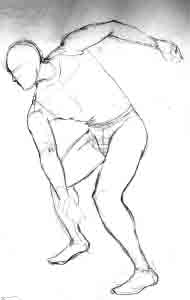
|
This is a figure of a man preparing to throw a discus. Once you get the handle of the cylinder body, you will find it is an invaluable tool. I use cylinder bodies every day, to study action figures and to create the dynamic positioning of figures in my art. Before we get into doing very extreme anatomy and actions, let's continue our study by adding some surface detail to the structures we can now create!
|
|
|
|
Once you get the handle of creating the cylinder body, you will find it to be an invaluable tool. I use cylinder bodies every day, to study action figures and to create the dynamic positioning of figures in my art. Before we get into doing very extreme anatomy and actions, let's continue our study by adding some surface detail to the structures we can now create!
The art accompanying this tutorial was completed by me when I was a 22 years old aspiring comic book artist!
|

